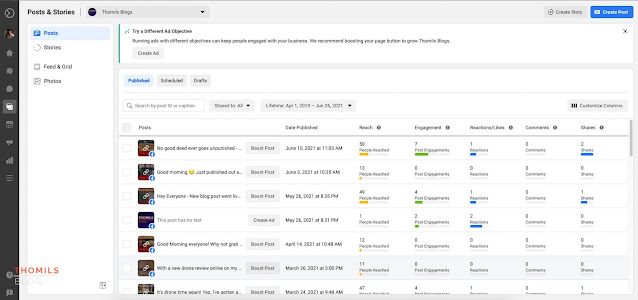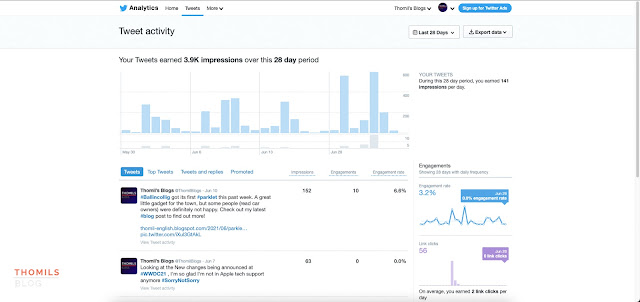Blogging - Publish & Perish?
When you don’t know what to write about, write about writing. Yep, it’s that time again, time to lift the veil about my working methods as a blogger, as I’m running low on ideas at the moment. When it comes to blogging, writing a blog post is only part of the process and one could actually argue that it's one of the easiest parts of the entire blogging process. Deep in their hearts, all bloggers have a certain self-presentation neurosis, a certain narcissistic streak, so of course, they'll want their musings to be read by as large an audience possible. Now all major blogging platforms offer powerful tagging and SEO options, and you’d think that blogger.com in particular, being owned by Alphabet and closely integrated into the Google ecosystem, is leading the pack, making it easy for your blog to be discovered and read. Unfortunately, given the sheer number of blogs out there, not to mention the questionable nature of some of them, this is not the case by a long shot. Which means I need to advertise my blog quite heavily.
For me personally, this is often the hardest part of the process. I've got no real problem with publishing posts that are eight hundred, a thousand, twelve hundred or two thousand words long. I’ve also gotten somewhat proficient at creating proper thumbnails. But coming up with a snappy call to action for my Twitter or Facebook Feed? Good luck with that! I’ve had situations where I spent more time worrying about that aspect than I did on curating the images and header image for the blog post I wanted to promote. This invariably leads to some questionable tag lines and teasers. And that’s before we get into the issue of which platforms to promote your blog on, especially when you’re just running your blog as a private endeavour and are not really looking to sink tons of cash into it.
As some of my regular readers will probably know, I promote my blog on Facebook and Twitter. I've dabbled in Instagram, but while that platform is great for general self-aggrandizement, promoting individual articles, or even YouTube videos is pretty much impractical on there. That leaves me with a hangout space for weirdos and an echo chamber filled with conspiracy theorists and people who blindly share every decrepit meme and insipid motivational quote out there. Basically, I've got the choice between cholera and dysentery, it's just different degrees of shittyness, basically Fifty Shades of Brown!
That in itself is not an issue, after all, a click is a click is a click. With both Facebook and Twitter having upwards of a billion users, some of them supposedly actual humans, the audience is theoretically large enough. Theoretically, that is. Both platforms throttle the reach of posts that aren't promoted. Facebook in particular seems to be particularly reluctant to share posts that contain links to external sites. Like, you know, a blog or a YouTube channel. This leads to the situation that a post that you may, between drafting out the idea, writing the article out, curating the images and macgyvering together a header image in Photoshop, have spent days on may only get a dozen or so views.
 |
| As powerful as Facebook's Page Manager is, it doesn't solve the issue of artificially throttled reach. |
 |
| It is clear that Facebook has aimed this squarely at larger companies with the corresponding advertising budgets. Small contributors don't figure in their business strategy. |
That is the reason why I started a dedicated Facebook Page just for my blogging efforts a few years ago. And in fairness, the management platform that Facebook provides for these Pages is a pretty powerful tool, maybe a bit too powerful for me. Still, it is a valuable tool for those wishing to promote their own content without ceaselessly spamming their friends on social media about their latest random ramblings. Even with that page manager though, I find myself struggling to increase the reach of my posts. My post about the Parklet in Ballincollig, which at the time I’m writing this is my most recent published blog post, has set at a reach of 50 users for the last five days.
 |
| Twitter's Analytics & Advertising section is at least a whole lot easier to read. |
Now the answer could of course be to bite the bullet and pay for Facebook or Twitter to promote and advertise my blog posts. However, as far as I’m concerned, that cannot be the only answer. Granted, advertising is the business model for all major social networks, not least the one run by a certain sociopathic loner. Still, paid promotion isn’t all that. I tried it back in 2017, and while I did get some additional followers for my blog page, it didn’t really bring in as much as I’d have liked. The amount of money needed to properly promote my page is out of all proportion to my current aim of treating the page as effectively a hobby. The same situation is in place on a smaller scale over on Twitter. There as well, it is very hard to get traction for any new post I put out, though that is somewhat more understandable as my Twitter following is significantly smaller than even the numbers of Facebook followers for my blogging page. Twitter does have the advantage though that a creative use of hashtags can really boost the visibility of your tweets. Plus, there are a lot more direct referrals coming to my blog from Twitter than there are from Facebook, even if a Facebook post does for some reason reach a wide audience.
This situation leaves me in a bit of a bind. I do not want to continue promoting my blog posts to my Facebook friends or with my personal Twitter account as I do not want to come across as a spammer. Yet, I’m not really left with a choice, apart from paying significant amounts of money which I can’t really justify for what is in essence a hobby. Besides, I’d like that money to go into new gadgets instead. So, to all those friends of mine who see my repeated posts pop up on their Facebook feeds, there’s a valid reason for that, apart from me being a cheap bastard.





Comments
Post a Comment